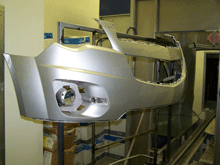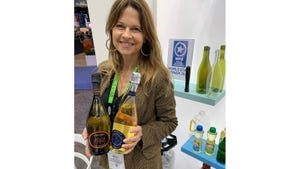Company aims to re-make painting of plastics
Painting of plastics, or any material, can be a very costly process, with the costs even higher if environmental responsibility is on the agenda. But Alliance Surface Finishing thinks its powder-coating process could be a game changer in the way all plastics are painted. "This will change the way the world paints," predicts Robert Langlois, CEO and president of the company.
March 4, 2010
Painting of plastics, or any material, can be a very costly process, with the costs even higher if environmental responsibility is on the agenda. But Alliance Surface Finishing thinks its powder-coating process could be a game changer in the way all plastics are painted. "This will change the way the world paints," predicts Robert Langlois, CEO and president of the company.
Alliance's patented powder on plastics process extends the coatable range of plastic substrates. "Instead of 375°F cure temperatures, which is the industry standard, ours is a low-temperature cure process," Langlois explains. Alliance's exclusive low-cure technology allows for cure temperatures of 200-250°F, temperatures low enough so that users have the ability to powder coat most parts that currently are liquid painted.
|
Low-temperature curing and no VOCs could make this process very attractive for decorating plastics. |
The company (Vaughan, ON) has formalized partnerships with leading suppliers of powder paint, resins, spray and automation equipment, and others, says Langlois. Eventually he wants to license the ASF patented technology globally, and to have additional company-owned power-coating facilities located in Georgia, Tennessee, and Mexico to have good coverage of North America.
The company already has significant commercial business, including coating snowmobiles and ATVs. In one instance, an OEM manufacturing snowmobiles had specified a TPO (thermoplastic olefin) that scratched and had poor UV resistance—hardly good qualities in a material for a snowmobile's outer cowling. After Alliance finished powder coating the parts, though, "They had a 9-peel finish with our coating," says Langlois.
According to Langlois, the company has run hundreds of parts made of about 40 different grades of TPO through its coating lines and ovens successfully, as well as parts molded of polypropylene and PC/ABS. "We've never seen any issues with fillers or additives hindering the results," he adds. The coating also appears to help scratches on TPO parts to disappear, he says, so much so that the company also filed a patent on that. This "self-healing" property would mean parts suppliers would not need to use as much packaging when shipping parts, he notes.
Automotive Tier One and OEM testing have validated that the Alliance low-cure technology produces a significantly better-looking part, having a peel rating of 8+, and increased DOI over existing liquid paint technologies, says Langois. The powder-coated parts also have demonstrated an increased mar and chip resistance as evidenced in gravelometer testing, which means fewer warranty issues.
The Alliance process creates no VOCs (volatile organic compounds) or HAP (hazardous air pollutant) emissions, he says, and reduces overall costs compared with liquid paints and coatings with a performance that matches or beats those. As far as cost, he says, "If you had $1 million-$2 million to put into a compact powder coating line, you could have a fully automated Class A one from us complete with ABB robots." Langlois reckons the cost of one of his company's powder coating lines is about 1/20th the cost of a wet paint line. "Operating costs go way down," he says.
He reckons his company is striking on hot irons as automotive OEMs and Tier Ones and Twos consolidate their manufacturing into fewer facilities. "This is the time to get rid of paint lines," he figures. Plus, for plastics processors, the pressure is on to offer additional finishing and decoration services. "If a molder cannot offer finishing service, he'll lose business," notes Langlois. Allied Surface Finishing has patented the apparatus and process it uses, and would like to license it globally. Some of the powder technology used is exclusive to the firm and patented too.
The process can be used to coat plastics and metals on the same coating line, though metals cure much faster, meaning it may make sense to handle them separately. The company has entered into an exclusive partnership with ITW Gema, a leader in powder gun technology, to globally market and promote Alliance's latest development, a patent-pending process to apply two coats of powder in a single booth—first a base coat and then a clear coat, and co-cure them. "Fewer steps inherently means higher yield," states Langlois, and also would lead to about 40% lower consumption of powder. Combining both in a single booth and co-curing also seems to improve the smoothness of a plastic part's surface.—[email protected]
About the Author(s)
You May Also Like



